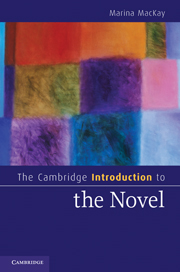Book contents
- Frontmatter
- Contents
- Acknowledgments
- About this book
- Chapter 1 Why the novel matters
- Miguel de Cervantes, Don Quixote (1605, 1615)
- Chapter 2 Origins of the novel
- Laurence Sterne, The Life and Opinions of Tristram Shandy, Gentleman (1759–67)
- Chapter 3 Narrating the novel
- James Hogg, The Private Memoirs and Confessions of a Justified Sinner (1824)
- Chapter 4 Character and the novel
- Nathaniel Hawthorne, The Scarlet Letter (1850)
- Chapter 5 Plotting the novel
- Gustave Flaubert, Madame Bovary (1857)
- Chapter 6 Setting the novel
- Charles Dickens, Bleak House (1853)
- Chapter 7 Time and history
- Virginia Woolf, To the Lighthouse (1927)
- Chapter 8 Genre and subgenre
- Graham Greene, The Ministry of Fear (1943)
- Chapter 9 Novel and anti-novel
- Thomas Pynchon, The Crying of Lot 49 (1966)
- Chapter 10 Novel, nation, community
- Salman Rushdie, Midnight's Children (1981)
- Chapter 11 Concluding
- Notes
- Glossary
- Further reading
- Index
- Cambridge Cultural Social Studies
About this book
Published online by Cambridge University Press: 05 June 2012
- Frontmatter
- Contents
- Acknowledgments
- About this book
- Chapter 1 Why the novel matters
- Miguel de Cervantes, Don Quixote (1605, 1615)
- Chapter 2 Origins of the novel
- Laurence Sterne, The Life and Opinions of Tristram Shandy, Gentleman (1759–67)
- Chapter 3 Narrating the novel
- James Hogg, The Private Memoirs and Confessions of a Justified Sinner (1824)
- Chapter 4 Character and the novel
- Nathaniel Hawthorne, The Scarlet Letter (1850)
- Chapter 5 Plotting the novel
- Gustave Flaubert, Madame Bovary (1857)
- Chapter 6 Setting the novel
- Charles Dickens, Bleak House (1853)
- Chapter 7 Time and history
- Virginia Woolf, To the Lighthouse (1927)
- Chapter 8 Genre and subgenre
- Graham Greene, The Ministry of Fear (1943)
- Chapter 9 Novel and anti-novel
- Thomas Pynchon, The Crying of Lot 49 (1966)
- Chapter 10 Novel, nation, community
- Salman Rushdie, Midnight's Children (1981)
- Chapter 11 Concluding
- Notes
- Glossary
- Further reading
- Index
- Cambridge Cultural Social Studies
Summary
Many of the eighteenth-century critics who observed the appearance of this new literary species would have been astounded to learn that the frivolous, fashionable “novel” so beloved of silly females would eventually be considered deserving of a scholarly introduction (with the Cambridge University Press imprimatur, no less!). And not even the novelists themselves could have imagined that they were contributing to what would ultimately become the major literary form of modern times, both inside and outside the university. This book begins by telling the story of that extraordinary rise, before going on to describe in more detail the particular formal characteristics and qualities we associate with the novel. Later chapters are concerned with types of novel: the genre novel, the experimental novel, the novel of nation and community.
Each chapter addresses a formal or historical aspect of the novel, drawing examples and illustrations from a range of novels often from very different times and places. Between these main chapters are more sustained readings of individual works, intended to suggest how the generalizations of the summary chapters might be put to specific uses. Arranged mostly in the order of their publication, these interchapters collectively offer, well, certainly not the story but one story of the novel running from Cervantes to Rushdie. But these should be considered optional reading, and, if the main chapters work as they were intended, student readers will be able to think of favorite novels with which to replace mine.
- Type
- Chapter
- Information
- The Cambridge Introduction to the Novel , pp. ix - xPublisher: Cambridge University PressPrint publication year: 2010

